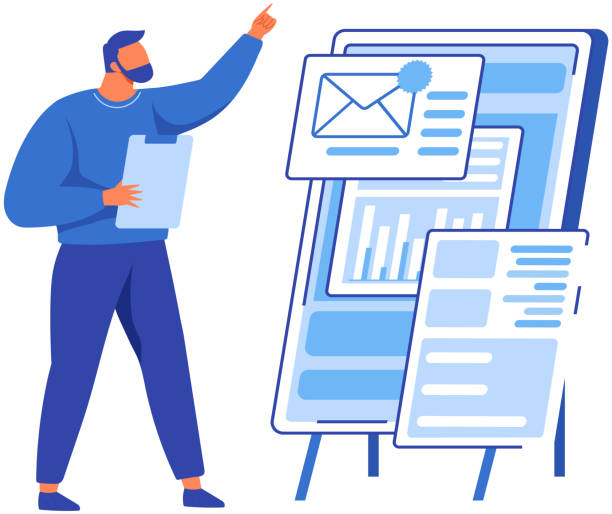Introduction to the Principles of Fast Website Design and Its Importance

In today’s digital world where speed is paramount, fast website design is considered more than a competitive advantage; it’s a vital necessity.
One can no longer expect success in user acquisition and sales growth with a slow and heavy website.
Internet users have little patience, and statistics show that most of them abandon a website if it doesn’t load within a few seconds.
The importance of #loading speed not only directly impacts user experience (UX) but also significantly affects #SEO and site rankings in search engines.
Google and other search engines prioritize high-speed websites, which means greater visibility and higher traffic for your business.
In this chapter, we will explain the general concept of high-speed website design and why its importance is growing.
This explanatory approach will help you gain a deeper understanding of the challenges and opportunities in this field.
A speed-optimized website not only satisfies users but also reduces bounce rates and increases conversion rates.
Therefore, investing in website speed optimization is a strategic step for any business aiming for success in the online space.
Does your current corporate website present a worthy image of your brand and attract new customers?
If not, turn this challenge into an opportunity with Rasaweb’s professional corporate website design services.
✅ Significantly improves your brand’s credibility and image.
✅ Smooths the path for attracting leads and new customers.
⚡ For free and specialized consultation, contact Rasaweb now!
Key Components in Website Speed Optimization

To achieve a fast website design, special attention must be paid to several key components.
The first, and perhaps most important, factor is #Server Response Time.
A powerful and optimized hosting can make a big difference in your website’s initial speed.
Choosing a reputable hosting provider suitable for your website’s needs is crucial.
The second component is #optimized coding and resource compression.
HTML, CSS, and JavaScript codes should be as compressed and organized as possible to reduce their loading time.
Removing unnecessary codes, combining files, and using the Minification technique are among these measures.
The third factor is #image and media optimization.
High-volume images can severely reduce site speed.
Using optimized image formats like WebP, compressing images without losing quality, and Lazy Loading for images outside the user’s view are effective solutions.
Adhering to these educational and specialized components forms the basis of an agile website design and is essential for any web developer or online business owner.
Tools like Google PageSpeed Insights can help you identify speed bottlenecks.
Leading Tools and Technologies for Building High-Speed Websites

Today, numerous tools and technologies are available to achieve fast website design, making the work easier for developers.
One of the most important is the use of optimized Content Management Systems (CMS) like WordPress with powerful caching plugins (such as WP Rocket or LiteSpeed Cache).
These plugins significantly reduce loading times by storing static versions of pages.
The second key technology is the #Content Delivery Network (CDN).
CDNs store your website’s content on multiple servers worldwide and deliver content from the server closest to the user, leading to reduced latency and increased speed.
Furthermore, tools for compressing code, images, and fonts, as well as using lightweight JavaScript frameworks (like React or Vue.js) that optimize the loading of different parts of a page, play a vital role in creating an agile website.
These specialized guidelines and tools help you turn high-speed website creation into a reality.
| Optimization Method | Description | Impact on Speed |
|---|---|---|
| Powerful Hosting | Choosing a server with sufficient resources and optimizing server settings | Very high, reduces initial response time |
| Caching | Storing static versions of pages for subsequent requests | High, reduces server load and speeds up reloads |
| Using CDN | Distributing content across global servers and delivering from the closest point | High, reduces network latency and faster content loading |
| Image Compression | Reducing the size of image files without significant quality loss | High, reduces overall page size and download time |
| Code Minification | Removing extra spaces and characters from HTML, CSS, and JS | Medium, reduces code file size and improves processing time |
| Lazy Loading | Loading images and videos only when the user needs them | High, improves initial page load speed |
The Impact of Speed on User Experience and SEO

Website loading speed heavily influences two main pillars of online success: #user experience and #SEO.
From a user’s perspective, a slow website can lead to frustration and site abandonment (increased #bounce rate).
Users expect information to be readily available, and loading delays can directly negatively impact the Conversion Rate.
No one wants to wait a long time for an online purchase, filling out a form, or even reading an article.
From an SEO perspective, search engines like Google consider speed an important ranking factor.
Google’s introduction of Core Web Vitals metrics has further highlighted the importance of this issue.
These metrics include Largest Contentful Paint (LCP), Cumulative Layout Shift (CLS), and First Input Delay (FID), all directly related to site speed and visual stability.
Therefore, fast website design not only helps user satisfaction but also leads to an improved position in search results and ultimately, business growth.
This analysis shows that speed optimization is a long-term investment with high returns.
Does your current website build the trust that potential customers should have in your business? If not, it’s time to have a professional and impactful corporate website with Rasaweb.
✅ Fully custom design tailored to your brand identity
✅ Increased lead generation and business credibility in customers’ eyes⚡ Contact us now for a free consultation!
Common Mistakes That Slow Down Your Website and Their Solutions

On the path to fast website design, we often encounter mistakes that can significantly reduce website speed.
Understanding these mistakes and their solutions is a crucial part of the optimization process.
One of the most common errors is using #large and unoptimized images.
Very high-quality images and inappropriate formats can severely slow down page loading.
The solution to this problem is image compression, using next-generation formats (like WebP), and implementing Lazy Loading.
Another mistake is #inefficient coding and using too many plugins or scripts.
Every extra plugin or script can consume server resources and increase loading time.
Thoroughly reviewing plugins, removing unnecessary ones, and optimizing custom codes are essential.
Also, #poor and low-quality hosting is a significant factor in site slowness.
Choosing a suitable and powerful hosting service is the foundation of your website’s speed.
Not using caching and CDN is also a common mistake.
By correctly implementing these solutions, site slowness can be prevented, and your website can be ensured to have fast and optimized performance.
Understanding these issues and applying the guided solutions is essential for anyone seeking better website performance.
The Role of Image and Media Optimization in Increasing Speed

Images and multimedia content are an integral part of modern user experience, but they can easily become the Achilles’ heel of fast website design.
The role of #image and media optimization in increasing website speed is critical.
High-volume images, without proper compression, can add tens of megabytes to the overall page size and severely increase loading time.
The first step in this direction is #image compression without noticeable quality loss.
Many online and offline tools are available for this purpose.
The second point is choosing the #WebP format.
This newer format stores images with similar quality and significantly smaller file sizes compared to JPG or PNG and is supported by most modern browsers.
Furthermore, implementing “Lazy Loading” for images and videos is of great importance.
With this technique, media content is loaded only when the user scrolls to the relevant section, which significantly improves the initial page loading speed.
Using responsive images features in HTML also allows the browser to select the most suitable image size based on the user’s screen size.
This specialized approach not only increases speed but also reduces user data consumption.
Data compression is an essential skill for every webmaster.
Mobile-First Approach and Its Connection to High-Speed Website Design

In an era where a significant portion of internet traffic comes from mobile devices, the #Mobile-First approach in fast website design has become increasingly important.
This approach means prioritizing design and development for smaller screens and then adapting it to desktops.
Websites not optimized for mobile not only provide a poor user experience but are also penalized by search engines.
#Responsive Design is a key component of this approach, ensuring that your website automatically adapts to the user’s screen size.
But beyond appearance, mobile loading speed is a critical factor.
Mobile networks can be slower, and users generally expect higher speeds.
Technologies like AMP (Accelerated Mobile Pages) by Google have been developed to provide extremely fast web pages on mobile and are an example of focusing on speed on the mobile platform.
This news analysis indicates that paying attention to mobile speed is no longer an option but a requirement for any online business seeking success and competitiveness.
This is the thought-provoking content that makes many businesses reflect.
| Core Web Vitals Metric | Abbreviation | Description | Desirable Threshold |
|---|---|---|---|
| Largest Contentful Paint | LCP | Time to load the largest content element on the page (image or text block) | Less than 2.5 seconds |
| First Input Delay | FID | Browser’s response time to the first user interaction (click or tap) | Less than 100 milliseconds |
| Cumulative Layout Shift | CLS | Amount of unexpected visual element shifts during page loading | Less than 0.1 |
| Interaction to Next Paint | INP | Response time to all user interactions during the page’s lifecycle (newest metric replacing FID) | Less than 200 milliseconds |
Monitoring and Maintenance of Website Speed

Fast website design is not a one-time process; rather, it’s an ongoing commitment to #monitoring and #maintaining website speed.
After initial optimizations are implemented, it is essential to regularly monitor your website’s performance.
Tools like GTmetrix, Google PageSpeed Insights, and Lighthouse can provide detailed reports on loading speed and potential bottlenecks.
These tools help you identify problems and implement the necessary solutions.
Additionally, regular updates of CMS, plugins, and site themes play a key role in maintaining its speed, as new versions often offer performance and security improvements.
Continuous database optimization and removal of extra content or unused plugins can also help maintain site agility.
This educational section shows that maintaining a high-speed website requires continuous attention and effort, but the result will be clearly visible in the form of a better user experience and higher search engine rankings.
Remember that every small change to a website can have a big impact on the final speed, so regular #speed testing is a vital habit.
Are you bothered by losing customers due to your e-commerce site’s outdated appearance or slow speed? Rasaweb’s expert team solves these problems with professional e-commerce website design!
✅ Increases customer trust and your brand’s credibility
✅ Stunning speed and excellent user experience
Get a free consultation with Rasaweb right now ⚡
Future Trends in Fast Website Design

The future of fast website design is rapidly evolving, and new trends are on the horizon promising incredible speeds.
One of these trends is the use of #Artificial Intelligence (AI) and Machine Learning (ML) for automated website optimization.
These technologies can intelligently manage resources and optimize content loading by analyzing user behavior and traffic patterns.
Additionally, new communication protocols like #HTTP/3, built on UDP, significantly increase data transfer speeds and minimize network latency.
New web development architectures like #Jamstack (JavaScript, APIs, Markup) also offer a different and faster approach to building websites by pre-generating static pages and using CDNs.
The concept of #Serverless also eliminates the need for server management, allowing developers to focus on coding and improving scalability and speed.
This thought-provoking content in the news domain indicates a future where websites will be faster, more stable, and smarter, and HTTP/3 is just one component of this revolution.
Final Advantages and Summary of Agile Website Design

Ultimately, implementing fast website design means investing in the future of your online business.
The benefits of this approach extend beyond merely faster page loading and encompass a wide range of achievements.
Increased user satisfaction and improved #user experience lead to a reduction in bounce rate and an increase in user retention time on the site.
This, in turn, strengthens customer loyalty and increases their likelihood of returning.
On the other hand, high speed directly positively impacts #SEO and site rankings in search engines, significantly increasing your visibility in the competitive online space.
This means more traffic, more sales leads, and ultimately, revenue growth.
A high-speed website not only presents a professional and up-to-date image of your brand but also differentiates you from competitors.
Given all these advantages, it is clear why every business should prioritize creating an agile website as a strategic priority.
This engaging summary shows that speed is the key to entering a wider market and achieving sustainable success in the digital world.
This is a fundamental step in your digital marketing.
Frequently Asked Questions
| No. | Question | Answer |
|---|---|---|
| 1 | What does fast website design mean? | Optimizing a website for fast page loading, improved user experience, and SEO ranking. |
| 2 | Why is site loading speed important? | Increased user satisfaction, reduced bounce rate, improved SEO, and increased conversion rate (sales/action). |
| 3 | What tools are available for testing site speed? | Google PageSpeed Insights, GTmetrix, Pingdom Tools are common tools. |
| 4 | What are the main factors slowing down a website? | Unoptimized images, heavy JavaScript and CSS codes, poor hosting, and lack of caching. |
| 5 | What is “Caching” and how does it help site speed? | Temporarily storing site data in the user’s browser or on the server for faster loading on subsequent visits. |
| 6 | How to optimize images to increase site speed? | Reducing image size (compression) without significant quality loss, using modern formats (WebP), and setting appropriate dimensions. |
| 7 | What role does CDN (Content Delivery Network) play in fast website design? | Distributing website content across various servers worldwide to deliver content from the server closest to the user. |
| 8 | Does choosing suitable hosting (web hosting) affect site speed? | Yes, quality hosting and powerful servers are essential for fast site loading. |
| 9 | What is the Minification technique and why is it used? | Removing extra characters (white spaces, comments) from HTML, CSS, JavaScript codes to reduce file sizes. |
| 10 | What is the relationship between responsive design and site speed? | Responsive design means correct display on different devices; if not implemented correctly, it can create extra load and reduce speed. Responsive optimization is important for speed. |
And other services of Rasa Web Advertising Agency in the field of advertising
Smart Social Media: Professional optimization to increase click-through rates using precise audience targeting.
Smart Social Media: Professional optimization for digital branding using marketing automation.
Smart SEO: A dedicated service for improving SEO rankings based on marketing automation.
Smart Digital Advertising: A combination of creativity and technology to attract customers through marketing automation.
Smart Website Development: An innovative service to enhance campaign management through key page optimization.
And over a hundred other services in the field of internet advertising, advertising consultation, and organizational solutions
Internet Advertising | Advertising Strategy | Advertorials
Resources
10 Ways to Increase Your Site Speed
Comprehensive Guide to WordPress Speed Increase
Why Site Speed Matters for SEO?
Principles of Fast and Efficient Website Design
? Rasaweb Afarin: Your digital partner for growth and visibility in the online world. From custom website design to SEO optimization, we offer comprehensive solutions for your business success.
📍 Tehran, Mirdamad Street, next to Bank Markazi, Southern Kazerun Alley, Ramin Alley No. 6


